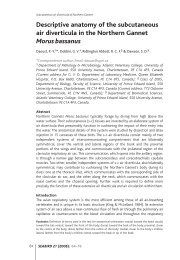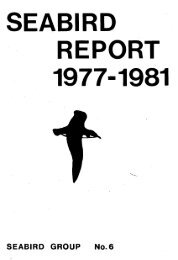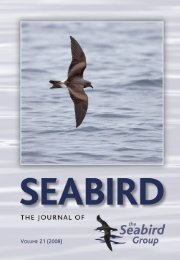You also want an ePaper? Increase the reach of your titles
YUMPU automatically turns print PDFs into web optimized ePapers that Google loves.
168 I. LANGSETH ET AL. Atlantic <strong>Seabird</strong>s 3(4)<br />
chamber at a rate of ca. 2.2 l min -1 . <strong>The</strong> actual flow-rate was constantly<br />
measured by a flow-meter (Bronkhorts Hi-tek, type 201C-FA). Effluent air was<br />
dried over silica-gel and a fraction of the dry effluent air was directed into an<br />
oxygen analyser (Servomex, type 244A) for measurement of oxygen<br />
concentration. Readings of Ta and the voltage output of the flow-meter and the<br />
oxygen-analyser were recorded every minute by a data-logger (Grant Squirrel,<br />
type 1203) and transferred to a computer for further analysis. <strong>The</strong> birds were<br />
weighed to the nearest 1.0 g immediately before and after each experiment,<br />
which on average lasted for 10 hours. A linear decrease in body mass was<br />
assumed when calculating the body mass, from which the mass-specific BMR<br />
was calculated. <strong>The</strong> birds (except 16, which were sacrificed and used in studies<br />
of body composition) were released outside the laboratory. All were observed<br />
back on their nests within a couple of hours afterwards.<br />
Rates of oxygen consumption were calculated using formula 3A in<br />
Withers (1977) and assuming a respiratory quotient of 0.8. We used the method<br />
described by Niimi (1978) in order to correct for washout delay and to obtain<br />
instantaneous rates. <strong>The</strong> minimum 25 minutes running mean was considered to<br />
represent the basal metabolic rate (for further details on method see Bech et al.<br />
1999). Oxygen consumption values were converted into Watts (W) using a<br />
factor of 20.1 kJ per litre of oxygen.<br />
A number of nests, 48 in 1997 and 55 in 1998, were randomly selected<br />
as controls. Hatching rates, chick growth and chick survival were similar for the<br />
experimental nests and the control nests (pers. obs.). Hence, removal of the<br />
females from their nests during the BMR measurements did not seem to have<br />
any deleterious effect on reproduction. <strong>The</strong> mean body mass and BMR values<br />
obtained during the incubation period did not differ significantly between the<br />
two seasons (1997 and 1998), nor did the means obtained during the chick<br />
rearing period. Hence, we have not analysed the data for the two seasons<br />
separately in this study. All statistical analyses were performed using SigmaStat<br />
software (SPSS Inc., v. 2.03). Values are presented as means ± 1 standard<br />
deviation (SD) and the results were considered statistically significant at values<br />
of P ≤ 0.05. <strong>The</strong> National Committee for Animal Research (Forsøksdyrutvalget)<br />
in <strong>No</strong>rway approved the experimental protocol for the experiments. Permissions<br />
to work in the colony and the collection of individuals for analyses of body<br />
composition were obtained from the Governor of Svalbard (ref. 96/00569-2 and<br />
98/00469-5).








